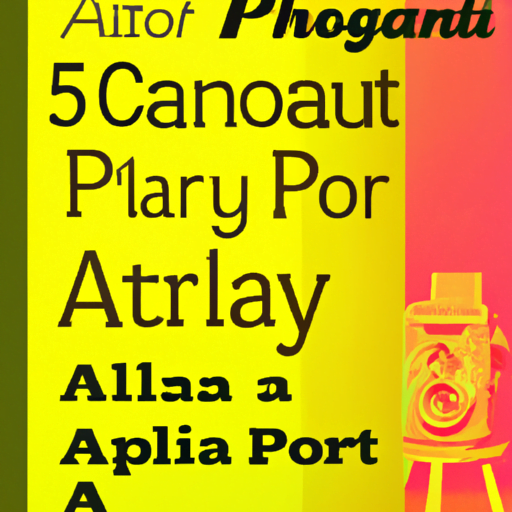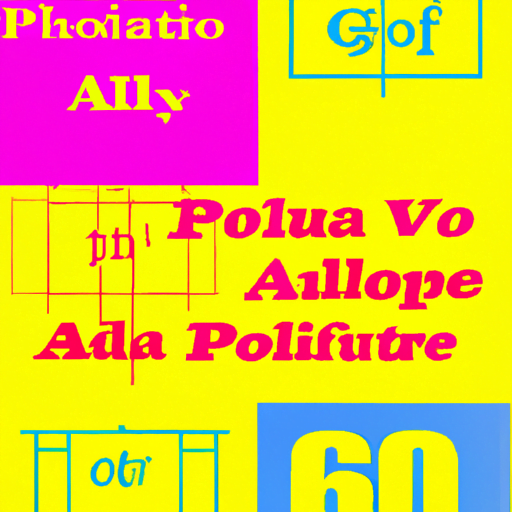
-
Table of Contents
- The Role of Typography in Graphic Design
- The Power of Typography
- The Elements of Typography
- Typeface
- Font Size and Weight
- Spacing and Alignment
- Hierarchy and Contrast
- Case Studies: Effective Typography in Graphic Design
- 1. Apple
- 2. Coca-Cola
- 3. Airbnb
- The Future of Typography in Graphic Design
- Variable Fonts
- Experimental Typography
- Responsive Typography
- Conclusion
The Role of Typography in Graphic Design

Typography is an essential element of graphic design that plays a crucial role in conveying messages, evoking emotions, and creating a visually appealing experience for the audience. It involves the art and technique of arranging type to make written language readable and visually appealing. In this article, we will explore the significance of typography in graphic design and how it can enhance the overall design aesthetic.
The Power of Typography
Typography has the power to make or break a design. It can influence how people perceive and interpret information, evoke emotions, and create a memorable experience. Here are some key reasons why typography is so important in graphic design:
- Communication: Typography is a visual language that helps communicate the intended message effectively. The choice of typeface, font size, and spacing can impact how easily the text is read and understood.
- Branding: Typography plays a vital role in establishing and maintaining a brand’s identity. Consistent use of typography across various design elements helps create a cohesive and recognizable brand image.
- Emotional Impact: Different typefaces evoke different emotions. For example, a bold and modern typeface may convey a sense of strength and confidence, while a handwritten script font may evoke a feeling of elegance and nostalgia. Typography can enhance the emotional impact of a design.
- Visual Hierarchy: Typography helps establish a visual hierarchy within a design, guiding the viewer’s attention and emphasizing important information. By varying font sizes, weights, and styles, designers can create a clear hierarchy that enhances readability and user experience.
- Legibility and Readability: Good typography ensures that the text is legible and readable, even at different sizes and in various contexts. Proper spacing, line height, and contrast between the text and background are crucial for ensuring readability.
The Elements of Typography
Typography encompasses various elements that contribute to the overall design. Understanding these elements is essential for creating effective and visually appealing typography. Let’s explore some of the key elements:
Typeface
A typeface refers to a set of characters that share a common design. It is often referred to as a font, although technically, a font is a specific weight, style, or variant within a typeface. Typefaces can be classified into different categories such as serif, sans-serif, script, display, and more. Each typeface has its own unique characteristics and conveys a different mood or style.
For example, serif typefaces, with their small decorative lines at the ends of characters, are often associated with tradition, elegance, and formality. Sans-serif typefaces, on the other hand, are more modern, clean, and minimalistic in appearance.
Font Size and Weight
The size and weight of a font play a crucial role in typography. The size determines how prominent the text appears, while the weight refers to the thickness or heaviness of the characters. By varying the font size and weight, designers can create visual contrast and hierarchy within a design.
For example, headings are often set in larger and bolder fonts to grab attention, while body text is usually set in smaller and lighter fonts for better readability.
Spacing and Alignment
Spacing and alignment are essential aspects of typography that affect readability and visual appeal. Proper spacing between letters, words, and lines ensures that the text is easy to read and understand. It also helps create a harmonious balance within the design.
Alignment refers to how the text is positioned within a layout. Common alignment options include left-aligned, right-aligned, centered, and justified. Each alignment choice creates a different visual effect and should be selected based on the overall design goals.
Hierarchy and Contrast
Creating a clear hierarchy and contrast within typography is crucial for guiding the viewer’s attention and emphasizing important information. By using different font sizes, weights, and styles, designers can establish a visual hierarchy that helps users navigate through the content.
Contrast can be achieved through variations in font size, weight, color, or even typeface choice. It helps create visual interest and makes the text more engaging and memorable.
Case Studies: Effective Typography in Graphic Design
Let’s take a look at some real-world examples of how typography has been effectively used in graphic design:
1. Apple
Apple is known for its clean and minimalistic design aesthetic, and typography plays a significant role in their branding. They use a simple and elegant sans-serif typeface called “San Francisco” across their products, marketing materials, and website. The consistent use of this typeface helps create a cohesive and recognizable brand image.
2. Coca-Cola
Coca-Cola’s logo is one of the most recognizable in the world. The logo features a unique script typeface known as “Spencerian Script.” This handwritten style font evokes a sense of nostalgia and tradition, aligning with the brand’s long history and heritage.
3. Airbnb
Airbnb’s typography is designed to reflect their brand values of inclusivity and diversity. They use a custom typeface called “Cereal” that combines geometric shapes with humanist characteristics. This unique typeface helps create a friendly and approachable brand image.
The Future of Typography in Graphic Design
As technology continues to evolve, so does the role of typography in graphic design. Here are some emerging trends and advancements that are shaping the future of typography:
Variable Fonts
Variable fonts are a relatively new technology that allows for more flexibility and control over typography. Unlike traditional fonts that come in fixed styles and weights, variable fonts enable designers to adjust various parameters such as weight, width, and slant within a single font file. This opens up new possibilities for dynamic and responsive typography.
Experimental Typography
Designers are increasingly pushing the boundaries of typography by experimenting with unconventional layouts, type treatments, and interactions. This trend allows for more creative expression and helps brands stand out in a crowded digital landscape.
Responsive Typography
With the rise of mobile devices and responsive web design, typography needs to adapt to different screen sizes and resolutions. Responsive typography involves using techniques such as fluid typography, where font sizes and spacing adjust automatically based on the screen size. This ensures optimal readability and user experience across devices.
Conclusion
Typography is a powerful tool in graphic design that goes beyond mere aesthetics. It plays a crucial role in communication, branding, emotional impact, visual hierarchy, and readability. By understanding the elements of typography and leveraging its potential, designers can create visually appealing and effective designs that leave a lasting impression on the audience.
